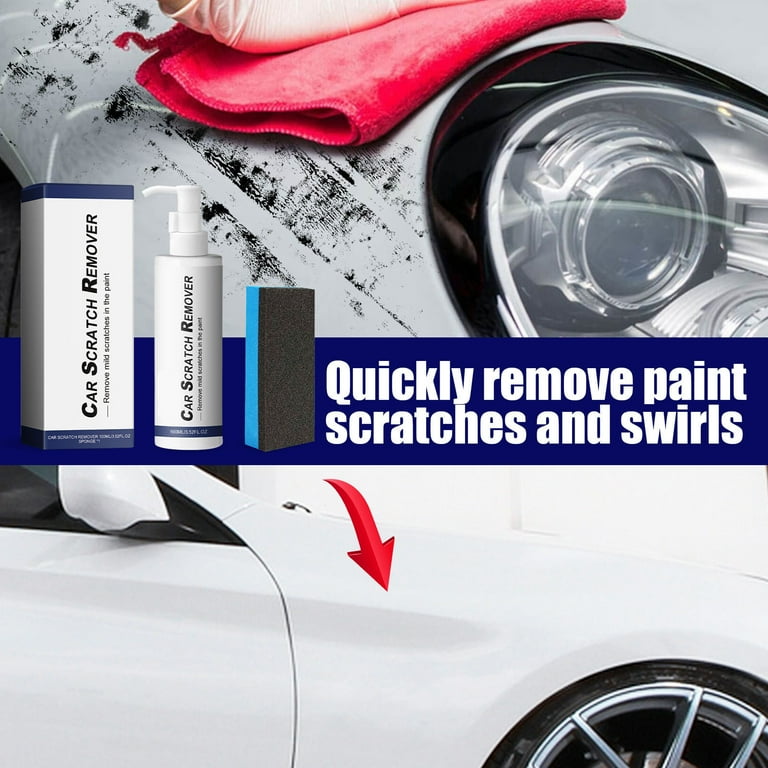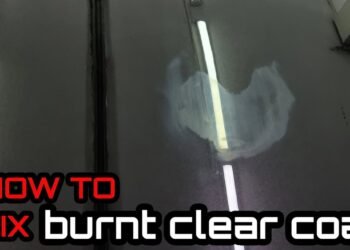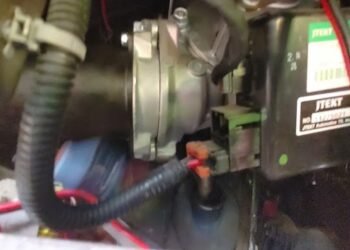Have you ever found unwanted oil paint splattered on your car’s body and wondered how to get it off without causing damage? It’s frustrating to see those stubborn paint spots ruining your car’s shiny finish.
But don’t worry—removing oil paint from your car’s body is easier than you think when you know the right steps. You’ll discover simple, effective methods to clean your car safely, restore its smooth look, and protect it from future harm.
Keep reading, and you’ll learn exactly how to bring your car back to its pristine condition.

Credit: dumondglobal.com
Tools And Materials Needed
Removing oil paint from a car body requires the right tools and materials. Using proper supplies helps protect your car’s finish while effectively cleaning the paint. Gather everything before starting for a smooth process.
Clay Bar And Lubricant
A clay bar gently lifts paint splatters without scratching the car’s surface. Use it with a lubricant spray to prevent rubbing damage. The lubricant helps the clay bar glide smoothly, removing fresh or light oil paint spots easily.
Solvents And Cleaners
Stronger paint stains need solvents like mineral spirits, turpentine, or lacquer thinner. These dissolve dried oil paint but require careful use. Acetone can also remove paint, but test a small area first to avoid damage. Use soft cloths to apply solvents and wipe immediately to prevent harm.
Polishing And Waxing Supplies
After paint removal, polishing restores the car’s shine. Use a mild polishing compound and a soft pad for best results. Finish with wax to protect the paint and keep the surface smooth. These steps help maintain the car’s original look and safeguard against future stains.
Initial Cleaning Steps
Removing oil paint from a car body requires careful preparation. The initial cleaning steps help protect the car’s original paint. Starting with gentle methods reduces the risk of damage. These steps prepare the surface for deeper cleaning if needed.
Washing The Car Surface
Begin by washing the car with soap and water. Use a car shampoo that is gentle on paint. Rinse thoroughly to remove dirt and dust. Dry the surface with a clean microfiber towel. This step clears away loose particles. It prevents scratching during the next cleaning stages.
Using A Clay Bar For Fresh Paint
A clay bar removes fresh paint overspray safely. Spray a lubricant on the affected area first. Gently glide the clay bar over the paint surface. The clay pulls off paint spots and contaminants. Avoid applying too much pressure. Wipe the area with a microfiber cloth after claying. This method keeps the car’s paint smooth and clean.
Removing Light Oil Paint
Light oil paint on a car body can be tricky to remove without harming the clear coat. It usually appears as small splatters or thin layers on the surface. Acting quickly helps prevent the paint from bonding deeply. Gentle methods work best for these cases. They clean the paint without scratching or dulling the car’s finish.
Two popular and safe techniques involve using a clay bar with lubricant and a microfiber towel with a special cleaning solution. Both methods focus on easing the paint off the surface while protecting the original paint beneath. These steps are easy to follow and require minimal tools.
Clay Bar Lubricant Techniques
The clay bar is a soft, malleable tool designed to pick up contaminants from car paint. Start by spraying a clay bar lubricant generously over the affected area. This spray creates a slick surface that prevents scratching.
Rub the clay bar gently back and forth across the paint. The clay will pull up the oil paint particles. Avoid pressing too hard to keep the car’s paint safe. Wipe the area with a clean microfiber cloth after claying to remove loosened paint and lubricant residue.
This method works well for fresh and light paint overspray. It smoothens the surface and prepares it for polishing or waxing. Clay bars are affordable and reusable if cleaned properly after use.
Microfiber Towels And Onr Solution
Another gentle way to remove light oil paint is using microfiber towels combined with an ONR solution. ONR stands for Optimum No Rinse. It is a mild cleaner that loosens paint without harsh chemicals.
Dampen a microfiber towel with the ONR solution. Rub the paint spots softly in circular motions. The oil paint should begin to lift away. Use a clean part of the towel often to avoid spreading paint back onto the car.
This method is safe for all paint types and helps protect the car’s shine. It also reduces the risk of scratches. After treatment, rinse the area lightly with water and dry with a fresh microfiber cloth to finish.
Handling Stubborn Paint Spots
Stubborn oil paint spots on your car body require careful handling. These spots often resist simple cleaning methods. Using strong solvents can help but needs caution. Protect your car’s finish while removing tough paint marks. Apply each solvent gently and check results frequently.
Applying Mineral Spirits Or Turpentine
Mineral spirits and turpentine are effective for softening oil paint. Use a clean cloth with a small amount of solvent. Rub the paint spot gently in circular motions. Wipe the area immediately after the paint starts to lift. Avoid soaking the car’s surface to prevent damage.
Using Lacquer Thinner Safely
Lacquer thinner is stronger and can dissolve stubborn paint spots. Test a small hidden area first to check for adverse effects. Apply lacquer thinner with a soft cloth, rubbing lightly. Remove the paint residue quickly to protect the car’s paint layer. Always work in a well-ventilated space.
Careful Use Of Acetone
Acetone can remove oil paint but may harm the car’s finish. Use it sparingly and only on persistent spots. Dab a little acetone on a cloth and rub gently. Wipe off the area right after paint removal. Test acetone on a hidden spot before applying widely.
Finishing Touches
After removing oil paint from your car’s body, the finishing touches are vital. These steps ensure your car looks clean and polished. They also protect the paint and keep it shiny for longer. Follow these simple tasks to complete the process.
Washing Off Residue
Use clean water and car shampoo to wash the area. This removes leftover paint remover and dirt. Rinse thoroughly to avoid streaks or spots. Dry the surface with a soft microfiber cloth. This prevents water marks and prepares the car for polishing.
Polishing To Restore Shine
Apply a small amount of polishing compound on a soft cloth. Rub gently in circular motions over the treated area. Polishing removes haze and minor scratches caused by paint removal. It brings back the car’s natural shine and smoothness. Wipe off excess polish with a clean cloth.
Applying Protective Wax
Choose a good quality car wax for the final layer. Apply a thin, even coat using an applicator pad. Wax protects the paint from dirt and UV rays. Let the wax dry until it becomes hazy, then buff it off with a soft cloth. This step adds a glossy finish and long-lasting protection.

Credit: www.walmart.com
Safety Tips
Removing oil paint from a car body requires careful handling of chemicals and tools. Safety must come first to protect yourself and your vehicle. Follow these safety tips to avoid harm and damage during the cleaning process.
Testing Solvents On Small Areas
Always test any solvent on a small, hidden spot first. This step checks for color changes or damage to the car’s paint. Wait a few minutes after applying to see the effect. If the area looks normal, it is safer to proceed. Skip using solvents that harm the paint or clear coat.
Wearing Protective Gear
Protect your skin and eyes by wearing gloves and safety goggles. Solvents and chemicals can cause irritation or burns. Use long sleeves to avoid skin contact. Choose gloves made of nitrile or rubber for better protection. Avoid breathing in fumes by covering your mouth with a mask if needed.
Proper Ventilation
Work in a well-ventilated area to reduce exposure to harmful fumes. Open windows and doors if indoors. Use fans to increase airflow around your workspace. Avoid working in enclosed spaces without fresh air. Good ventilation helps keep you safe and comfortable while removing oil paint.
Preventing Future Paint Damage
Protecting your car’s paint from oil paint and other contaminants is key to keeping its surface smooth and shiny. Preventing future paint damage saves time and money on repairs. Simple habits can keep your car’s body looking fresh for years. Below are practical ways to protect your car’s paint and avoid costly damage.
Using Car Covers
Car covers shield your vehicle from dust, dirt, and paint splatter. They block harmful UV rays that fade paint over time. Choose a cover made from soft, breathable fabric to avoid scratching the surface. Always cover your car when parked outdoors for long periods. This creates a strong barrier against environmental damage.
Avoiding Paint Overspray Areas
Paint overspray can stick to your car in places near construction or painting work. Avoid parking near these zones to prevent paint from landing on your vehicle. Watch for spray painting activity in neighborhoods or garages. Staying clear of these spots reduces the chance of unwanted paint stains on your car body.
Regular Maintenance Practices
Wash your car regularly to remove dirt and pollutants that harm paint. Use gentle car soaps and soft cloths to avoid scratches. Apply wax every few months to add a protective layer against contaminants. Inspect your car often to spot paint issues early. Quick attention prevents small problems from growing bigger.

Credit: www.reddit.com
Frequently Asked Questions
How Do You Get Oil Paint Off A Car?
Use a clay bar with lubricant to gently remove fresh oil paint. For dried paint, apply mineral spirits or lacquer thinner carefully. Always test solvents on a small area first. After removal, wash, polish, and wax the car to restore and protect the paint finish.
Can Dried Oil Paint Be Removed?
Yes, dried oil paint can be removed using solvents like mineral spirits, turpentine, or lacquer thinner. Test a small area first. Use a clay bar for light spots. Always wash, polish, and wax the surface after removal to protect the original finish.
How To Get Rid Of Oil Paint On Body?
Use a cloth with mineral spirits or turpentine to gently rub off oil paint. For fresh spots, try a clay bar with lubricant. Wash and dry skin afterward. Avoid harsh chemicals on sensitive areas. Moisturize skin to prevent dryness after cleaning.
Does Wd-40 Remove Oil Paint?
WD-40 can help loosen oil paint but may not fully remove it. Use mineral spirits or lacquer thinner for better results. Always test on a small area first.
How Can I Remove Fresh Oil Paint From My Car Body?
Use a detailing clay bar with lubricant spray to gently lift fresh paint without damage.
Conclusion
Removing oil paint from your car body takes patience and care. Start with gentle methods like a clay bar to avoid damage. Use stronger solvents only on small test areas first. Always clean and polish after removing paint to restore shine.
Protect your car’s finish with wax once the job is done. Taking these steps helps keep your car looking its best. Remember, a careful approach saves time and effort later. Your car will thank you for the attention and care.

















